
Suffield is a town in Hartford County, Connecticut, United States. The town is part of the Capitol Planning Region, and located in the Connecticut River Valley. As of the 2020 census, the population was 15,752. The town center is a census-designated place listed as Suffield Depot.

Dummerston is a town in Windham County, Vermont, United States. The population was 1,865 at the 2020 census. It is home to the longest covered bridge still in use in Vermont. Its borders include three main villages: Dummerston Center, West Dummerston, and East Dummerston.

The Connecticut River is the longest river in the New England region of the United States, flowing roughly southward for 406 miles (653 km) through four states. It rises 300 yards south of the U.S. border with Quebec, Canada, and discharges at Long Island Sound. Its watershed encompasses 11,260 square miles (29,200 km2), covering parts of five U.S. states and one Canadian province, via 148 tributaries, 38 of which are major rivers. It produces 70% of Long Island Sound's fresh water, discharging at 18,400 cubic feet (520 m3) per second.
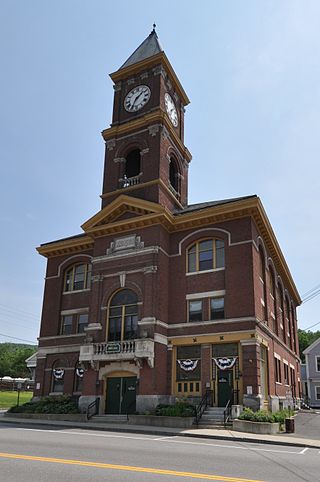
Hinsdale is a town in Cheshire County, New Hampshire, United States. The population was 3,948 at the 2020 census. Hinsdale is home to part of Pisgah State Park in the northeast, and part of Wantastiquet Mountain State Forest in the northwest.
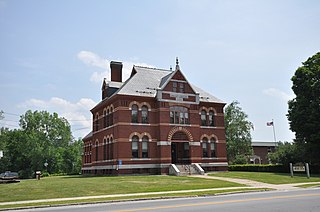
Winchester is a town in Cheshire County, New Hampshire, United States. The population was 4,150 at the 2020 census. The primary community in the town, where 1,606 people resided at the 2020 census, is defined by the U.S. Census Bureau as the Winchester census-designated place (CDP). The town also includes the village of Ashuelot and part of Pisgah State Park.

Brattleboro, originally Brattleborough, is a town in Windham County, Vermont, United States, located about 10 miles (16 km) north of the Massachusetts state line at the confluence of Vermont's West River and Connecticut. With a 2022 Census population of 12,106, it is the most populous municipality abutting Vermont's eastern border with New Hampshire, which is the Connecticut River.

The Province of New Hampshire was a colony of England and later a British province in New England. The name was first given in 1629 to the territory between the Merrimack and Piscataqua rivers on the eastern coast of North America, and was named after the county of Hampshire in southern England by Captain John Mason, its first named proprietor. In 1776 the province established an independent state and government, the State of New Hampshire, and joined with twelve other colonies to form the United States.
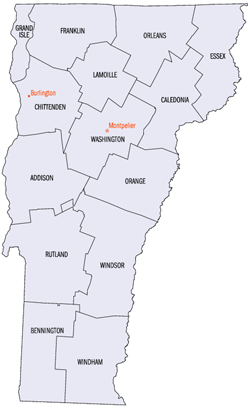
The New Hampshire Grants or Benning Wentworth Grants were land grants made between 1749 and 1764 by the colonial governor of the Province of New Hampshire, Benning Wentworth. The land grants, totaling about 135, were made on land claimed by New Hampshire west of the Connecticut River, territory that was also claimed by the Province of New York. The resulting dispute led to the eventual establishment of the Vermont Republic, which later became the U.S. state of Vermont.

Joseph Dudley was a colonial administrator, a native of Roxbury in Massachusetts Bay Colony, and the son of one of its founders. He had a leading role in the administration of the Dominion of New England (1686–1689), which was overthrown in the 1689 Boston revolt. He served briefly on the council of the Province of New York, from which he oversaw the trial which convicted Jacob Leisler, the ringleader of Leisler's Rebellion. He then spent eight years in England in the 1690s as Lieutenant-Governor of the Isle of Wight, including one year as a Member of Parliament for Newtown. In 1702, he returned to New England after being appointed governor of the Province of Massachusetts Bay and Province of New Hampshire, posts that he held until 1715.
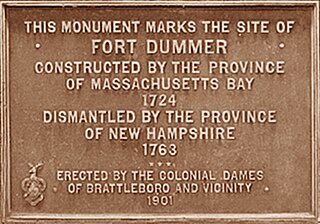
Fort Dummer was built in the winter of 1724 in what is now the Town of Brattleboro in southeastern Vermont. Today, it is notable as the first permanent European settlement in Vermont. The original site of the fort is now lost below the waters of the Connecticut River impoundment of the Vernon Dam.

William Dummer was a politician in the Province of Massachusetts Bay. He served as its lieutenant governor for fourteen years (1716–1730), including an extended period from 1723 to 1728 when he acted as governor. He is remembered for his role in leading the colony during what is sometimes called Dummer's War, which was fought between the British colonies of northeastern North America and a loose coalition of native tribes in what is now New Hampshire, Maine, New Brunswick, and Nova Scotia.

The geologic history of Vermont begins more than 450 million years ago during the Cambrian and Devonian periods.
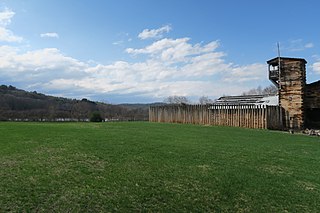
The Fort at Number 4 was a mid-18th century stockade fortification protecting Plantation Number 4, the northernmost British settlement along the Connecticut River in the Province of New Hampshire until after the French and Indian War. It was located in the present-day town of Charlestown, New Hampshire. A recreation of the fort, dating to 1960, now functions as an open-air museum, and was added to the New Hampshire State Register of Historic Places in July 2020.

The area that is now Massachusetts was colonized by English settlers in the early 17th century and became the Commonwealth of Massachusetts in the 18th century. Before that, it was inhabited by a variety of Native American tribes. Massachusetts is named after the Massachusett tribe that inhabited the area of present-day Greater Boston. The Pilgrim Fathers who sailed on the Mayflower established the first permanent settlement in 1620 at Plymouth Colony which set precedents but never grew large. A large-scale Puritan migration began in 1630 with the establishment of the Massachusetts Bay Colony, and that spawned the settlement of other New England colonies.
Lygonia was a proprietary province in pre-colonial Maine, created through a grant from the Plymouth Council for New England in 1630 to lands then under control of Sir Ferdinando Gorges. The province was named for his mother, Cicely (Lygon) Gorges. It was one of the early provinces of Maine and was absorbed by the Massachusetts Bay Colony by 1658.

Union Station is an Amtrak intercity rail station located in downtown Brattleboro, Vermont, United States. It is served by the one daily round trip of the Vermonter service. Most of the 1915-built station is occupied by the 1972-opened Brattleboro Museum and Art Center, while Amtrak uses a waiting room on the lower floor. The building was added to the National Register of Historic Places in 1974.
The Connecticut River Railroad was a railroad located along the Connecticut River in western Massachusetts, formed in 1845 from the merger of two unfinished railroads. Its main line from Springfield to East Northfield, Massachusetts, opened in stages between 1845 and 1849. It built several branches and over the years acquired additional lines in Vermont. The railroad was acquired by the Boston and Maine Railroad in 1893.

Gray Lock, , was a Western Abenaki warrior chieftain of Woronoco/Pocumtuck ancestry who came to lead the Missisquoi Abenaki band, and whose direct descendants have led the Missisquoi Abenaki until the current day. Born around 1670 near what is now Westfield, Massachusetts, he eventually became the most illustrious and prominent leader to arise among the dwindling Waranoak, once the predominant original inhabitants of the central Connecticut River Valley in today's New England region.
The siege of Fort at Number Four was a frontier action at present-day Charlestown, New Hampshire, during King George's War. The Fort at Number 4, was unsuccessfully besieged by a French and Native force under the command of Ensign Joseph Boucher de Niverville. The British defenders were alerted to the presence of the besiegers by their dogs, and were well-prepared to defend the fort. They successfully fought off attempts to burn the fort down, and turned down demands that they surrender. Some of Boucher de Niverville's Natives, short on provisions, attempted to bargain with the fort's defenders for supplies, but were rejected.
Samuel Knight was a legal and political figure in Vermont during its period as an independent republic and the early years of its statehood. Among the offices in which he served were Associate Justice of the Vermont Supreme Court, and Chief Justice (1791-1793).
















